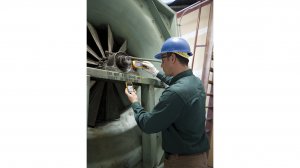Testing technology provider Comtest offers its Fluke 805 vibration meter which measures overall vibration, bearing vibration and temperature simultaneously for clients such as frontline mechanical troubleshooting teams and machine operators of high-end process facilities.
This includes the petrochemicals, pulp and paper, primary metals, utilities and food product sectors which are specific about inconsistencies in results when using vibration screening devices.
Vibration in rotating machinery is merely the back and forth movement or oscillation of a machine and components, such as drive motors, driven devices such as pumps and compressors, and the bearings, shafts, gears, belts and other elements that make up mechanical systems.
The company says vibration itself is not a problem. However, excess vibration is simply a symptom of internal issues, such as bearing failures, imbalance, misalignment and looseness, that shorten equipment lifespan.
More than half of unplanned downtime is attributed to mechanical failures. While many things can impact the life of a machine, once the first signs of failure appear, it generally has only a matter of months before failing completely.
Vibration testing provides a way to determine where a machine is on the failure curve, allowing maintenance teams to react as needed.
The higher the overall vibration of a machine the worse the condition is.
Bearing condition is assessed automatically with use of Crest Factor Plus (CF+) and temperature is often used as a second opinion that confirms the bearing assessment based on vibrations.
Trend plots on all available parameters are easily created by using either Fluid Connect or a free Microsoft Excel template.
Overall vibration values are used to create trend plots that help to predict the condition of a machine and to plan maintenance.
The machine condition of most common machinery can be determined instantly with alarm levels that are programmed in the product.
Fluke 805 promises reliable, repeatable results thanks to the innovative sensor and sensor tip design that minimises measurement variations caused by angle or pressure.
This unique sensor force sensor design compensates for the pressure applied during measurement and provides reliable results both for overall vibration of about 10 Hz to 1 000 Hz and bearing measurements of about 4 000 Hz to 20 000 Hz.
The Fluke 805 vibration meter provides a four level severity scale – good, satisfactory, unsatisfactory and unacceptable – for both overall vibration and bearing condition.
Rather than seeing unexplained lights or numerical indications, users can easily assess the severity of the situation with the Fluke 805’s text-based alerts.
The Fluke 805 can hold up to 3 500 measurements and if long-term trending is required, users can easily export data through a universal serial bus connection.
Notably no special software is needed because the product is shipped with a disk containing prebuilt Excel templates.
Edited by: Zandile Mavuso
Creamer Media Senior Deputy Editor: Features
EMAIL THIS ARTICLE SAVE THIS ARTICLE
ARTICLE ENQUIRY
To subscribe email subscriptions@creamermedia.co.za or click here
To advertise email advertising@creamermedia.co.za or click here













